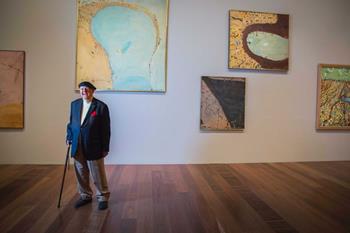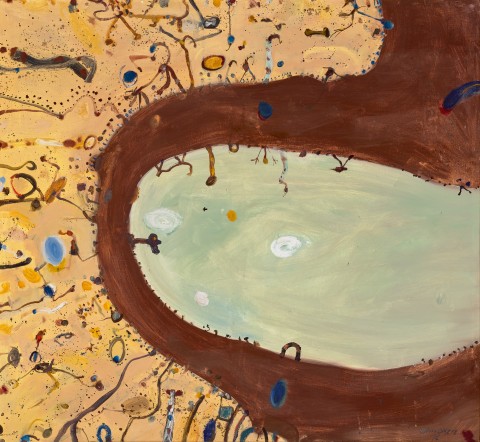DARK VOID, 1976
JOHN OLSEN
oil on canvas
137.0 x 152.0 cm
signed and dated lower right: John Olsen / 76
Australian Galleries, Melbourne (label attached verso)
Tolarno Galleries, Melbourne
The National Australia Bank Art Collection, acquired from the above in August 1977 (label attached verso)
John Olsen: Recent oil paintings, gouaches, drawings and etchings, Ray Hughes Gallery, Brisbane, 8 – 28 May 1976
John Olsen: Recent Works, Australian Galleries, Melbourne, 2 – 16 August 1977, cat. 3 (label attached verso)
Australian Art: Colonial to Contemporary, Deutscher Fine Art, Melbourne, May – June 1995, cat. 94 (illus. in exhibition catalogue, p. 71)
John Olsen: The You Beaut Country, The Ian Potter Centre: NGV Australia at Federation Square, Melbourne, 16 September 2016 – 12 February 2017, and Art Gallery of New South Wales, Sydney, 10 March – 12 June 2017
Hart, D., The Art of John Olsen, Doctor of Philosophy thesis, Faculty of Creative Arts, University of Wollongong, 1997, pl. 86, p. 150
Moncrief, M., ‘Recovery a fine art for NAB finance man’, The Age, Melbourne, 2 September 2006 (as ‘Dark Wood’)
McGrath, S., ‘A Remote Eden’, Art and Australia, Fine Arts Press, Sydney, vol. 14, no. 2, October - December 1976, pp. 148 (illus., dated as 1975), 150
Hart, D., John Olsen, Craftsman House, Sydney, 1991, pl. 86, pp. 138 (illus.), 214
McGregor, K., and Zimmer, J., John Olsen: Journeys Into the You Beaut Country, Thames and Hudson, Melbourne, 2016, pp. 32, 131 (illus.), 207
Ferrier, S., ‘John Olsen retrospective: More than 100 artworks capture Australian landscape’, ABC News, Melbourne, 15 September 2016
The Simpson Desert Approaching the Void, 1976, oil on canvas, 151.5 x 136.4 cm, in the collection of the Queensland University of Technology, Brisbane
210724 - 210725.jpg

For many artists, there is a motif to which they return at numerous points in their career, reinterpreting and drawing new inspiration. For Sidney Nolan, it was Ned Kelly; for Paul Cézanne, Mont Sainte-Victoire. For John Olsen, the motif is Lake Eyre. Its significance is such that Patrick McCaughey has described it as being central to 'four decades of Olsen's Dreaming'.1 ‘I've been nearly drowned on the blessed lake when our boat sank in a sudden storm; nearly been sucked under by the quicksand-like treacherous black mud; nearly been blown away by winds that howl in at midnight, buffeting your tent; I've had desert sand blow into my eyes, my paint, the camp oven, and ruin my beautiful fish paellas ... but all in all, I've had a fabulous time there.’2
Located 700 kilometres north of Adelaide, Olsen first visited Lake Eyre in October 1974 in the company of naturalist Vincent Serventy. They had journeyed to see the lake's largest flood in 500 years, an experience which profoundly affected the artist's way of interpreting his world. 'The lake might be viewed as an unconscious plughole of Australia, a mental landscape... Because it is 13 metres below sea level - and perhaps nowhere in Australia does one have the feeling of such complete emptiness - covered by a bowl of endless sky with inviting silences, there is, as you stand on the edge of the lake, a feeling that you are standing on the edge of a void.’3 For Olsen, Lake Eyre was important both visually and conceptually, as a place of contradictions – of fullness and emptiness, life and death.
Exploring these ideas about ‘the void’ and ‘the edge’, Dark Void, 1976 features prominently among the most important early paintings inspired by this encounter and significantly, was featured in the recent retrospective of John Olsen’s work organised by the National Gallery of Victoria, You Beaut Country (2017) alongside another major work on the subject, The Simpson Desert Approaching the Void, 1976 (Queensland University of Technology, Brisbane). Like the artist Ian Fairweather, who he greatly admired, Olsen was fascinated by Chinese art and literature, and found in the vast expanse of the lake a strong association with Sung Dynasty painting and the importance of space. Thus, in Dark Void, 1976 he presents a perfect encapsulation of his artistic predecessors’ interpretation of the void as evoking the concept of 'everything and nothingness', 'a place for contemplation, a vast, engulfing space.’4 Set on a highly tilted plane that may be viewed on a macro - and micro - level, Olsen here depicts the lake as it begins to dry up. In stark contrast to his interpretations elsewhere of the waterhole teeming with life, now he offers a tougher, more sombre, brooding sense of the place (and self) in the accentuation of the dark-brown rim of sludge around the lake, from which a very small self-portrait extends into its crystalline emptiness. As Olsen observed during one of his trips,
‘When full, Lake Eyre is Australia’s largest freshwater lake and teems with bird, fish and animal life. As the waters evaporate and it begins to recede it becomes progressively saltier, eventually returning to a dry saltpan where most forms of life are unable to survive…. At a certain point, the lake turns all crimson coloured. It becomes too salty. There’s millions of fish just lying on the edge, dead pelicans … There it is and there it isn’t.’5
1. McCaughey, P., Why Australian Painting Matters, The Miegunyah Press and Text Publishing, Melbourne, 2014, p.236
2. Olsen, quoted in Hawley, J., 'John Olsen', Encounters with Australian Artists, University of Queensland Press, Queensland, 1993, p.134
3. Olsen, quoted in Hart, D, John Olsen, Craftsman House, Sydney, 2000 (revised edition), p.133
4. Hart, D., ibid., p.135
5. Olsen, quoted in John Olsen: The You Beaut Country, National Gallery of Victoria, Melbourne, artwork labels.
ANDREW GAYNOR
